UPSC Daily Current Affairs - 27th June 2024 | Current Affairs & Hindu Analysis: Daily, Weekly & Monthly PDF Download
GS2/Polity
Role of a Lok Sabha's Leader of Opposition
Source: Indian Express
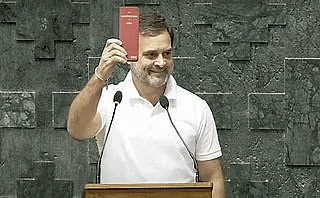
Why in news?
Congress leader Rahul Gandhi is Leader of Opposition (LoP) in the 18th Lok Sabha, a position that lay vacant for 10 years because no party had numbers equalling a tenth of the strength of the House.
- The LoP is the parliamentary chairperson of the largest political party/coalition in the Lok Sabha that is not in government.
The Position of Leader of Opposition in Lok Sabha and Rajya Sabha
- Statutory recognition: Officially described in the Salary and Allowances of Leaders of Opposition in Parliament Act 1977
- Numerical strength:
- Conventional understanding requires a party to have at least 10% of MPs in the House to get the post of Leader of Opposition
- Debate over numerical strength: Former Lok Sabha Secretary General PDT Achary mentioned that the Speaker is required to recognize the leader of the numerically largest party in opposition as the leader of opposition without a specific 10% rule
Powers of the Leader of Opposition (LoP) in the House
Order of precedence:
- LoP in Lok Sabha and Rajya Sabha come at No. 7 in order of precedence
- LoP enjoys certain privileges on ceremonial occasions
Sitting position in the House:
- LoP sits in the front row to the left of the Chair
- LoP is entitled to a seat in the front row during the Address by the President to both Houses of Parliament
Main duty of the LoP:
- LoP is the voice of the opposition in the House and is considered as a shadow Prime Minister with a shadow Cabinet
- LoP facilitates smooth functioning of the House's business
Practical role and responsibility:
- LoP is the opposition's representative in high-powered committees
- LoP is a member of crucial committees
GS1/Geography
COTTON CULTIVATION IN INDIA
Source: The Hindu
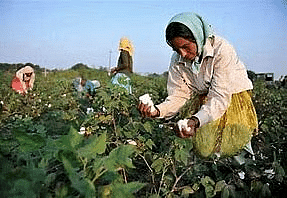
Why in news?
According to the Ministry of Textiles, the current marketing season (October 2023 to September 2024) has witnessed one of the highest cotton consumption rates by the textile industry in this decade. This period is projected to rank as the second highest in consumption over the past ten years, with an anticipated demand of 307 lakh bales, including 103 lakh bales from the MSME textile units.
Key Takeaways:
- India is considered the birthplace of the cotton plant.
- Despite losing a significant portion of cotton-growing areas to Pakistan during partition, India has substantially increased its acreage over the last 50 years.
- Cotton covers approximately 4.7% of the total cropped area in the country.
- Cotton is primarily a tropical or sub-tropical crop cultivated in semi-arid regions, particularly on the Deccan Plateau.
- Cotton is a Kharif crop, requiring 6 to 8 months to mature. It necessitates a minimum of 210 frost-free days and thrives with light rainfall (50 to 100 centimeters).
- Abundant sunshine during growth and a clear sky during flowering stages are crucial for cotton cultivation.
- Well-drained soil capable of retaining moisture is ideal for cotton cultivation, with a preference for black cotton soil.
Cotton-Producing States:
- North-West: Encompasses parts of Punjab, Haryana, and northern Rajasthan.
- West: Mainly Gujarat and Maharashtra.
- South: Includes plateaus in Telangana, Andhra Pradesh, Karnataka, and Tamil Nadu.
- Key cotton-producing states are Gujarat, Maharashtra, and Telangana. Other notable states are Madhya Pradesh, Karnataka, Andhra Pradesh, Tamil Nadu, Punjab, Haryana, and Uttar Pradesh.
GS2/International Relations
Sri Lanka seals debt deal with Official Creditor Committee
Source: Hindustan Times
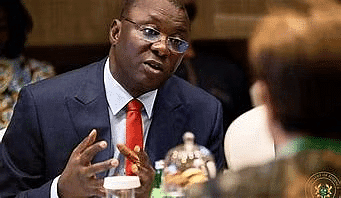
Why in news?
Sri Lanka reached a final restructuring agreement for $5.8 billion with its bilateral lenders’ Official Creditor Committee headed by India, Japan, and France
Background
- OCC is a group formed to represent the collective interests of creditors during the debt restructuring or bankruptcy process of a debtor, typically a corporation or sovereign entity.
About the OCC
- The OCC that has signed a deal with Sri Lanka recently refers to a specific ad-hoc group of official bilateral creditors, often formed to address the debt restructuring needs of a particular country.
- It was formed in May 2023 with the aim of simplifying Sri Lanka’s debt negotiations after the country defaulted on its external debt, in the wake of an unprecedented financial crash in 2022.
- Members
- The OCC is a platform comprising 17 countries including India and members of the Paris Club such as Japan, that have extended loans to Sri Lanka.
- Headquarters
- While not a permanent entity with a fixed headquarters, meetings for this OCC would typically be held in Paris, especially if coordinated with the Paris Club, which has its secretariat there.
- Role and Function
- The OCC's primary role is to negotiate and coordinate the restructuring of Sri Lanka’s external debt, ensuring a fair and sustainable resolution for the country's debt crisis.
- It is an informal group of official creditors (primarily major industrialized countries) that coordinates solutions for debtor countries facing payment difficulties.
- Paris, France.
- The Paris Club consists of 22 permanent member countries, which are primarily from Europe, North America, and Asia.
Recent Deal with Sri Lanka
- Background - Financial crisis in Sri Lanka
- Sri Lanka in mid-April of 2022 declared its first-ever sovereign default since gaining independence from Britain in 1948.
- The International Monetary Fund had made external debt restructuring conditional to the USD 2.9 billion bailout.
- Final restructuring agreement
- Sri Lanka reached a final restructuring agreement for $5.8 billion of debt with its bilateral lenders’ Official Creditor Committee in Paris.
- This agreement grants significant debt relief, allowing Sri Lanka to allocate funds to essential public services & secure concessional financing for development needs.
- Sri Lanka’s bilateral unpaid debt
- Sri Lanka’s total bilateral unpaid debt amounts to 10,588 million dollars.
- China pact
- China, Sri Lanka’s largest bilateral lender, opted to stay out of the platform but attended the discussions as an observer.
- Colombo has been negotiating its debt treatment with Beijing bilaterally and has clinched a deal.
- Significance of this agreement for Sri Lanka
- This agreement means that half of the government’s external debt by creditor countries and organizations has been restructured.
- Debt restructuring is a process used by companies, sovereign nations, or individuals facing financial distress to reorganize their outstanding debt obligations to make them more manageable and sustainable.
- This milestone demonstrates the strong progress made by Sri Lanka in stabilizing its economy and moving towards reform and growth.
- Role of India
- As one of the Co-Chairs of the OCC, along with France and Japan, India has been steadfast in its commitment to the stabilization, recovery, and growth of the Sri Lankan economy.
- This was also demonstrated by India’s unprecedented financial support of USD 4 billion.
- India was also the first creditor nation to convey financing assurances to IMF, which paved the way for Sri Lanka to secure the IMF program.
GS3/Environment
Impact of Coal Mining Pollutants on Workers
Source: The Hindu

Why in News?
Prolonged exposure to coal mining pollutants has led to widespread respiratory and skin diseases among workers and residents in six districts in India where coal extraction is a major occupation.
About the Study (Objective, Impact on Communities, Health Impact, Shift from Coal)
India's Dependency on Coal
- A survey conducted by the National Foundation for India, focusing on the impact of coal mining pollutants on mining workers in six districts.
- Districts surveyed: Koriya and Raigarh (Chhattisgarh), Dhanbad and Ramgarh (Jharkhand), Angul and Jajpur (Odisha).
- Key Findings:
- Impact on Marginalised Communities: 81.5% surveyed were from SC, ST, and OBC communities, facing challenges in income, education, and job opportunities.
- Impact on Health: Proximity to mines correlated with higher rates of respiratory and skin diseases.
- Shift from Coal: Study emphasizes the need for a 'just transition' away from coal-dependent jobs, anticipating economic impacts.
India's Dependence on Coal for Energy Supply
- Coal still accounts for about 70% of India's electricity despite increasing renewable energy capacity.
- Coal expected to contribute at least 21% to India's electricity needs by 2050.
- Advantages of Coal: Readily available domestically, supporting energy independence.
India's Developmental Needs
- Addressing poverty requires energy; India faces increasing energy demands as per the International Energy Agency.
- Diverse Energy Mix: India must rely on various energy sources to meet growing demands.
- Role of Coal in Employment: Coal sector provides jobs and supports industrial growth, employing millions directly and indirectly.
- Revenue from Coal: Coal mining contributes significantly to government revenue, with Coal India Limited being a major player.
GS3/Economy
INFLATION
Source: Economic Times
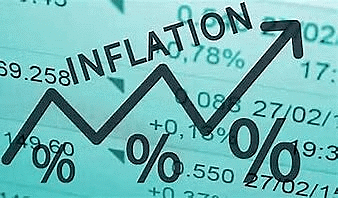
Why in news?
Reserve Bank of India (RBI) Governor Shaktikanta Das has recently emphasized the importance of managing inflation effectively. The central bank has been mandated by the government to keep inflation at 4% with a margin of 2% on either side.
About Inflation
- Inflation refers to the sustained increase in the general price level of goods and services in an economy over a period of time.
- It erodes the purchasing power of money and affects the standard of living.
Causes of Inflation
- Demand-Pull Inflation: Occurs when aggregate demand exceeds aggregate supply, leading to rising prices.
- Cost-Push Inflation: Arises due to increased production costs (e.g., higher wages, raw material costs).
- Built-In Inflation: A self-perpetuating cycle where expectations of future inflation lead to higher wages and prices.
Effects of Inflation
- Positive Effects:
- Debt relief for borrowers (as money becomes less valuable).
- Encourages spending and investment.
- Negative Effects:
- Reduced purchasing power for fixed-income earners.
- Uncertainty and instability in the economy.
Measuring Inflation
- Consumer Price Index (CPI):
- The CPI measures changes in the cost of a basket of goods and services consumed by households.
- Each category has a relative importance based on its share of total expenditures.
- Wholesale Price Index (WPI):
- The WPI reflects changes in wholesale prices of goods at the producer level.
- WPI helps understand cost pressures in production and supply chains.
Controlling Inflation
- Monetary Policy:
- Interest Rates: The RBI adjusts policy interest rates (like the repo rate) to influence borrowing costs. Higher rates can reduce demand and curb inflation.
- Open Market Operations (OMOs): The RBI buys or sells government securities to manage liquidity and influence interest rates.
- Cash Reserve Ratio (CRR): The CRR determines the portion of deposits banks must keep with the RBI. Adjusting it affects liquidity and lending capacity.
- Fiscal Policy:
- Taxation: Adjusting taxes affects disposable income and spending.
- Government Spending: Managing public expenditure impacts demand.
- Supply-Side Measures:
- Agricultural Reforms: Enhancing productivity and reducing supply bottlenecks in agriculture can stabilize food prices.
- Infrastructure Development: Improving infrastructure reduces production costs.
- Trade Policies: Facilitating imports can ease supply constraints.
Inflation Targeting Framework
- The Central Government, in consultation with the RBI, determines the inflation target in terms of the Consumer Price Index (CPI), once in five years and notifies it in the Official Gazette.
- The MPC determines the policy repo rate required to achieve the inflation target.
GS3/Environment
EUROPEAN UNION’S NEW NATURE RESTORATION PLAN
Source: The Hindu

Why in news?
The European Union recently approved its ambitious Nature Restoration Plan, a significant component of the bloc’s 2030 biodiversity strategy and the European Green Deal. This plan aims to restore degraded ecosystems across the continent.
Key Points
- The new law targets the restoration of ecosystems, species, and habitats across the EU's land and seas to promote biodiverse and resilient nature, support climate goals, and fulfill international commitments.
- Current statistics reveal that 81% of habitats in the EU have a "poor" status, and a concerning one-third of bee and butterfly species are experiencing declines.
- Targets of the legislation include covering at least 20% of the EU's land and sea areas by 2030 and restoring all ecosystems in need by 2050, with a focus on areas under the Natura 2000 network.
- Specific targets involve measures for urban, forest, marine, and agricultural ecosystems, pollinating insects, river connectivity, and iconic marine species.
- Examples of these targets include reversing pollinator decline, maintaining green urban spaces, increasing organic carbon stock, restoring drained peatlands, and enhancing river habitats for various species.
Implementation
- EU countries are required to submit National Restoration Plans to the Commission within two years, outlining their strategies for achieving the targets set forth.
- Monitoring and reporting on progress will be the responsibility of individual countries, with technical reports prepared by the European Environment Agency.
GS3/Science and Technology
CHINA’S SAMPLE RETURN LUNAR MISSION
Source: Deccan Herald
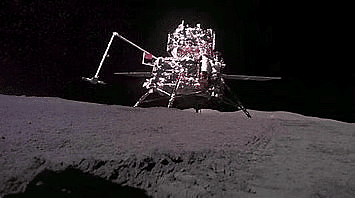
Why in news?
China’s Chang’e-6 on Tuesday made history by being the first spacecraft to bring back samples from the far side of the Moon, an area unseen from Earth. India’s Chandrayaan-4 mission, currently in progress by ISRO, is also set to undertake a sample return mission, with Chandrayaan-3 having landed about 600 km from the Moon's South Pole last year.
Key Takeaways
- The Chang’e-6 lander touched down on the Moon’s surface on June 1, spending two days collecting rocks and soil from the South Pole-Aitken (SPA) basin, one of the moon's oldest and largest craters, via a robotic arm and drill.
- Subsequently, an ascent module launched by the lander transferred the samples to the Chang’e-6 orbiter orbiting the Moon. On June 21, the orbiter released a service module that safely brought back the samples to Earth.
Historical Context
- In July 1969, the US Apollo 11 mission brought back 22 kg of lunar surface material, including 50 rocks.
- In September 1970, the Soviet Luna 16 mission, the first robotic sample return mission, also returned pieces of the Moon to Earth.
- Chang’e-5, the precursor to Chang’e-6, brought back 2 kg of lunar soil in December 2020, all collected from the near side of the Moon.
Technical Challenges
- Landing a spacecraft on the far side of the Moon posed significant technical challenges due to difficult terrain, large craters, and communication difficulties with ground control.
- The Moon's tidally locked nature means only one side faces Earth, making missions to the far side even more complex.
Significance of Sample Return Missions
- Sample return missions like Chang’e-6 aim to collect extraterrestrial samples for analysis on Earth, providing in-depth insights that in situ explorations cannot offer.
- By bringing samples to Earth, scientists can use advanced laboratory instruments to study them, preserving them for future research with even more sophisticated technology.
GS2/Polity
DEPUTY SPEAKER
Source: India TV

Why in news?
With the Opposition’s increased strength in Lok Sabha, its members are hoping to get the post of Deputy Speaker. There was no Deputy Speaker for the entire duration of the 17th Lok Sabha (2019-24).
- The first four Deputy Speakers, from 1952 to 1969, were from the ruling Congress. The Opposition had the post of Deputy Speaker continuously from 1990 through 2014.
Key takeaways
- According to Article 95(1), the Deputy Speaker performs the duties of the Speaker if the post is vacant.
- The Deputy Speaker has the same general powers as the Speaker when presiding over the House.
- All references to the “Speaker” in the Rules are deemed to be references to the Deputy Speaker as well for the times when he or she presides.
- Both the Speaker and Deputy Speaker must be appointed “as soon as may be”. Article 93 states that “The House of the People shall, as soon as may be, choose two members of the House to be respectively Speaker and Deputy Speaker”.
- Article 178 contains the corresponding provision for the Speakers and Deputy Speakers in the state Assemblies.
Is it mandatory under the Constitution to have a Deputy Speaker?
- The Constitution does not specify a time frame for making the appointments. It is this gap in the provision that allows governments to delay or avoid appointing a Deputy Speaker.
- However, constitutional experts have pointed out that both Article 93 and Article 178 use the words “shall” and “as soon as may be” – indicating that not only is the election of the Speaker and Deputy Speaker mandatory, it must be held at the earliest.
What are the rules for the election of the Deputy Speaker?
- The Speaker / Dy Speaker is elected from among the Lok Sabha members by a simple majority of members present and voting.
- The election of the Deputy Speaker usually takes place in the second session, even though there is no bar on having this election in the first session of the new Lok Sabha or Assembly. But the election of Deputy Speaker is generally not delayed beyond the second session unless there are some genuine and unavoidable constraints.
- In the Lok Sabha, the election of Deputy Speaker is governed by Rule 8 of the Rules of Procedure and Conduct of Business in Lok Sabha. According to Rule 8, the election shall be held on such date as the Speaker may fix.
- The Deputy Speaker is elected once a motion proposing his or her name is carried. Once elected, the Deputy Speaker usually continues in office until the dissolution of the House.
- Under Article 94 (and Article 179 for state Assemblies), the Speaker or Deputy Speaker shall vacate his office if he ceases to be a member of the House of the People. They may also resign (to each other), or may be removed from office by a resolution of the House of the People passed by a majority of all the then members of the House.
Additional Information:
- After the first Speaker, G V Mavalankar, died in 1956 before his term ended, Deputy Speaker M Ananthasayanam Ayyangar filled in for the remaining tenure of Lok Sabha from 1956 to 1957. Ayyangar was later elected as Speaker of the second Lok Sabha.
GS3/Economy
EXTERNAL DEBT TO GDP RATIO
Source: Business Standard
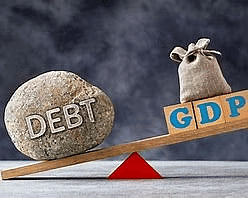
Why in news?
The ratio of external debt to GDP decreased to 18.7% by the conclusion of March 2024 from 19.0% in March 2023.
- India's external debt amounted to $663.8 billion by March 2024, showing a rise of 6% (around $39.7 billion) compared to March 2023.
About Innovation for Defence Excellence (iDEX)
External Debt:
- External debt comprises the total sum a nation owes to external lenders, encompassing foreign governments, international bodies, and private entities beyond its borders.
- It covers both short-term and long-term debt responsibilities.
- External debt is a subtype of public debt. Public debt denotes the overall amount a government owes to external creditors and domestic lenders.
Gross Domestic Product (GDP):
- GDP symbolizes the total value of all goods and services manufactured within a country's confines during a specific period, usually a year.
- It mirrors a nation's economic output and productivity.
Calculation of External Debt-to-GDP Ratio:
- The external debt-to-GDP ratio is computed by dividing the total external debt by the country's gross domestic product (GDP).
- This ratio aids in evaluating a country's financial stability and its capacity to handle debt obligations.
- A lower external debt-to-GDP ratio indicates that an economy generates adequate goods and services to reimburse its debts without accumulating further debt.
- Conversely, a higher ratio implies challenges in repaying external debts, potentially leading to heightened interest rates for borrowing.
Significance:
- As a nation's debt-to-GDP ratio escalates, its risk of default rises, potentially instigating financial turmoil in domestic and international markets.
- Governments strive to diminish this ratio, but in times of unrest (e.g., wartime or recession), borrowing may surge to stimulate growth.
|
55 videos|5389 docs|1141 tests
|
FAQs on UPSC Daily Current Affairs - 27th June 2024 - Current Affairs & Hindu Analysis: Daily, Weekly & Monthly
| 1. What is the role of the Leader of Opposition in Lok Sabha? |  |
| 2. How does cotton cultivation contribute to India's economy? |  |
| 3. What impact do coal mining pollutants have on workers? |  |
| 4. What is the significance of Sri Lanka sealing a debt deal with the Official Creditor Committee? |  |
| 5. How does the European Union's new Nature Restoration Plan aim to protect the environment? |  |





















